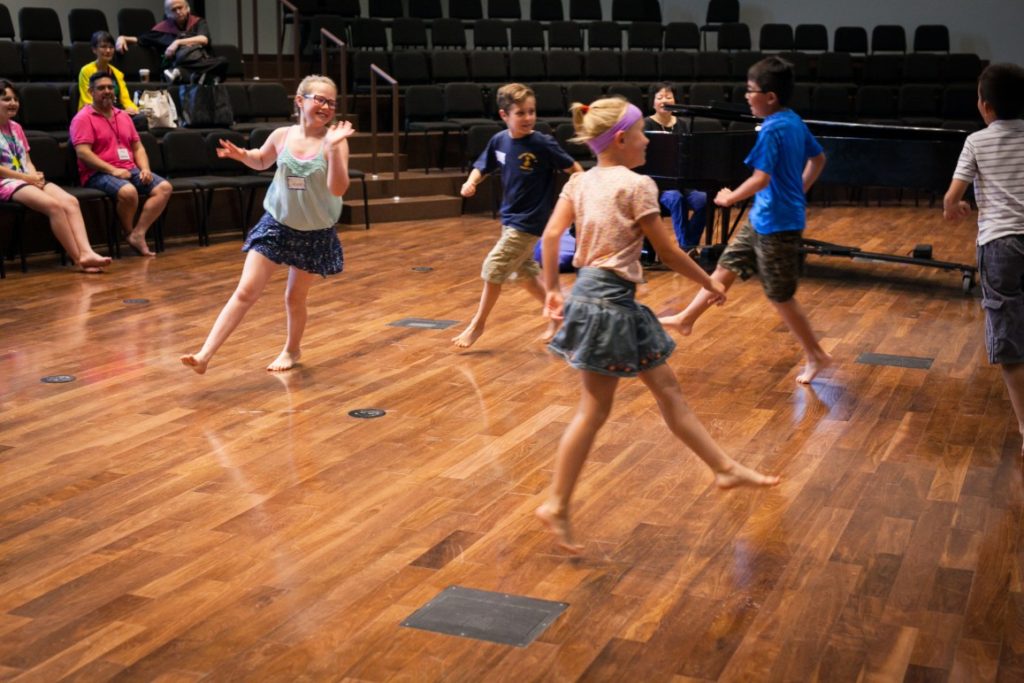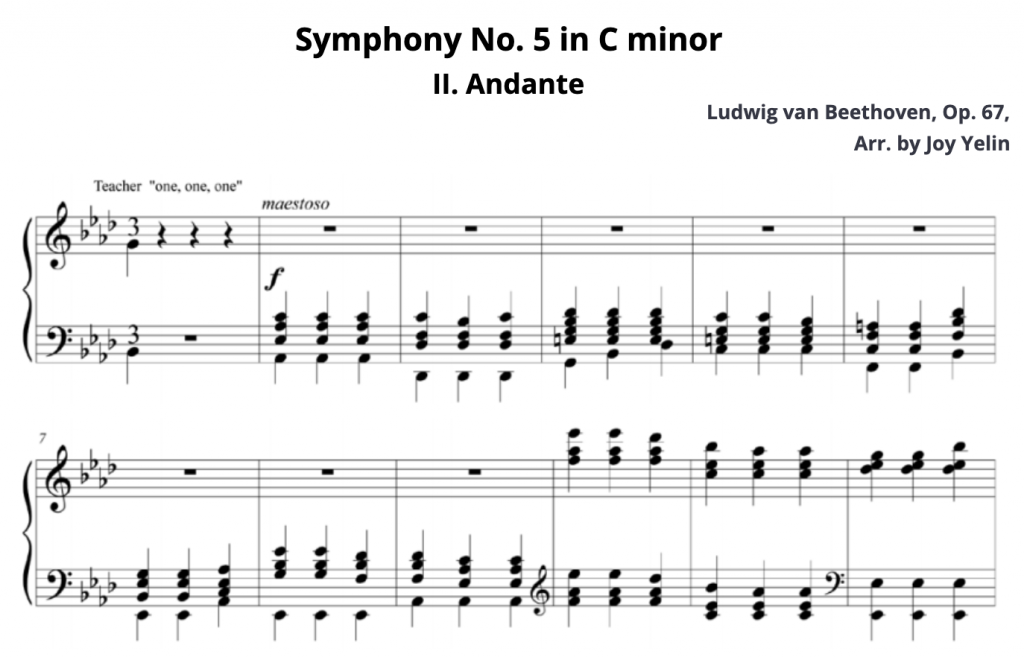
Lesson Plan Editorial: Andante from Symphony No. 5
A few weeks ago, we released Joy Yelin’s lesson on subdivision, which uses the Andante from Beethoven’s Symphony No. 5.
It is such a delight to use this familiar theme. With some tweaks here and there, I enjoy playing the marvelous melody, harmony and modulations of Ludwig van Beethoven’s “Andante.” The students move with rapt attention, responding to the subdivisions of the beat which are inherent in the music.
Begin with a slow tempo. The beat will be subdivided into eights, triplets, and finally sixteenths. The required movement, though exhilarating, can be tiring…especially the sixteenths! As the students recognize the music, I usually express my thanks to Beethoven for his marvelous gift for a Dalcroze lesson.
Joy Yelin
Joy’s description implies that the students will step either the beat or the subdivisions, taking one step per beat for quarter notes, two steps per beat for eighth notes, three steps per beat for eight-note triplets, etc.

This lesson illustrates several values that guide my own eurhythmics teaching: Developing Variation, Non-verbal Communication, Signals and Cues, Pacing, and Give and Take.
I vividly recall the energy and enthusiasm Joy Yelin brought to the eurhythmics classes she taught me over forty years ago, and all others I’ve had with her since then. We have remained good friends and colleagues, and I’m thrilled to have this opportunity to share my reflections on this lesson and its pedagogical insights.
This deceptively simple etude illustrates five of the values I strive to embody in my work as a eurhythmics teacher. These notes give me a chance to shed light on Joy’s ideas and tease out their pedagogical meaning:
- Developing Variation Cultivate the ability to devise variations on existing music, either before the lesson or on the spot.
- Non-verbal Communication Speak less and let the music “speak for itself” more, so the music may guide the students’ learning process (as well as their physical movement, of course).
- Signals and Cues While playing for students’ movement, support them by giving clear, well-timed signals and cues, musical or verbal.
- Pacing When you give your students opportunities to recover from their physical exertion, you can also give them opportunities to learn through other modalities such as singing, discussing, reading music, analysis, and writing.
- Give and Take Watch the students and notice each student’s distinctive movements. Your observations will enable you to guide their progress and growth. Notice what they do when they hear changes in the music. Do they respond instantly? Do they look at the others before responding? Let them make choices about how to respond, so they can reveal what they are hearing. As they do, reflect those choices in your improvised variations.

Developing Variation: An Operative Principle
I love how casually Joy lets slip here that she “enjoys playing the marvelous melody, harmony and modulations of Ludwig van Beethoven’s ‘Andante,’” introducing “some tweaks here and there.” Let’s take a closer look at these “tweaks”! In adapting this wonderful music to the specific needs of her students, Joy has shortened the time between the contrasts in rhythmic activity that Beethoven had introduced over the course of his long set of variations. Each composer’s design serves a different function. By gradually increasing rhythmic activity across several variations, Beethoven builds momentum to sustain the movement’s grand musical narrative. In contrast, by allowing her students to periodically reorient themselves to the primary level of pulsation, Joy sacrifices that long formal trajectory for something more immediate: Her students’ instant recognition of the quicker, shorter values that mark each variation.
How might you develop your skill at devising variations?
Continue reading the editorial commentary in the Lesson Plan below.
This lesson was originally published in the “American Dalcroze Journal” Vol. 40, No. 2.
Members of the Dalcroze Society of America can read and download this full lesson plan online. Not a member? Join instantly online.
Dear Bill, I was fortunate enough to study with you at Longy under Lisa Parker‘s direction that summer. I go by my middle name Scotty and we’ve spoken several times. Working with you I realized that it’s important I work with you again if your time permits. I live in Palm Springs California and I want to pursue Dalcroze methods and modalities again. Please let me know if this is a possibility with you or you are giving any workshops in the fall of 2022. If there is someone out here in Southern California that you would recommend I can begin to work with I would appreciate it. I have been teaching beginning piano to Marines and I have never ever seen such dedication to rehearsing. I have synesthesia as you know coupled with another situation and PTSD. I am still doing solo concerts(Piano). If you would let me know in the near future what your thoughts are I would appreciate it. Very very few people understand synesthesia and I know you have worked with other musicians with this situation and it is both an immense blessing and the opposite. Thank you for your time Dr. Bauer.Dalcroze has forever changed how I view the world. Sincerely, J. Scotty Beaty(760) 416-9853. Jsbmusic2002@aol.com